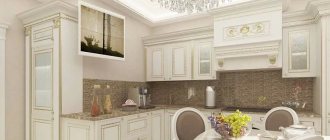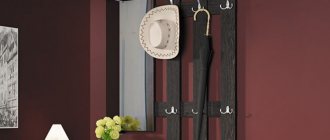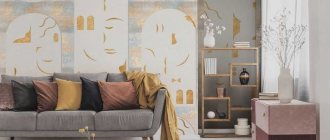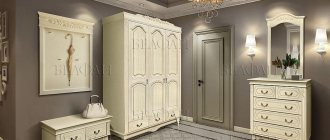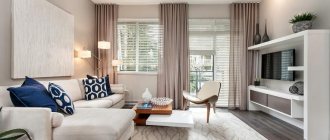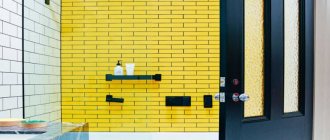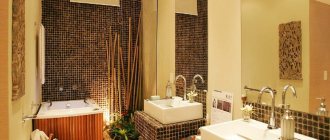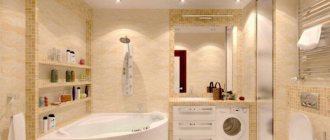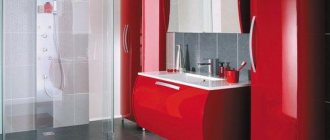During a major bathroom renovation, the problem of choosing a color scheme often arises. It's easy to get confused among the variety of options. Regardless of the style of the interior and the size of the room, you can use a universal method - decorate the bathroom in light colors. White and light shades evoke positive emotions and are associated with purity. In large quantities, they relax the gaze without concentrating attention on themselves. This environment creates a feeling of security and comfort, promotes relaxation and lifts your spirits.
Benefits of light colors
In addition to the positive impact on the psyche, the shades of the light palette are distinguished by functional features, including:
- Visual expansion of the room . A bright bathroom always seems larger. White walls create the illusion of increased space, as large light objects are perceived as distant.
- Practicality . At first glance, this is not obvious, since light colors are considered easily soiled by default. But in practice, light shades in bathroom decoration are superior to dark ones. This is demonstrated especially well by white or light-colored tiles: soap stains and traces of limescale from dried drops of water are practically invisible on them. For a neat appearance, it is enough to wash such tiles once a week, while dark or colored tiles need to be washed almost every day.
- Versatility . Light colors can be easily combined with each other and with rich and contrasting shades. The design of the bathroom in light colors makes it easy to choose the color of furniture and accessories. At the same time, the same bathroom with different accessories will look different. Therefore, you can update the decor of a bright bathroom with minimal time and money. In the simplest case, just change the color of the towels, bath curtains and other little things - and the room will look new. Replacing furniture facades can completely transform a room.
- Better illumination . Due to the admixture of a large amount of white, light colors better reflect the incident light, so with the same illumination, a white bathroom will always appear lighter than a black one.
Beautiful examples
The laconic design is an ideal choice for a small bathroom.
Light colors visually expand the space.
Focus on simple, clear shapes and silhouettes.
Expressive decor will add coziness to the room.
Compactness in everything will allow you to place everything you need in a small bathroom.
Selection of shades and their combinations
The bathroom design can be in monochrome light colors or combine two or three different shades. The larger the bathroom area, the more options for bold combinations. In most cases, light shades go well together, and warm and cool colors can also be combined with each other.
Light colors can be divided into three main groups: white, beige and pastel. They all have their own characteristics and deserve separate consideration.
White
White color in interior decoration always looks elegant and refreshes any interior. White contains all the colors of the visible spectrum and is the brightest of them. Shades of white are a win-win option for creating contrast with bright colors, as well as for softening harsh color transitions. It is appropriate in the bathroom like in no other room, since the classic design of the plumbing fixtures is provided in white. Therefore, for a harmonious perception of the interior, it is enough to support the plumbing with white furniture or finishing materials.
Not everyone is comfortable in a bathroom decorated entirely in white: many have associations with the walls of medical offices. To make the bathroom interior in the total white style look cozier, you can experiment with the texture of furniture and finishing materials: for example, combine glossy cabinet fronts with matte or relief tiles. An unobtrusive pattern on tiles, mosaics or panels will enliven the interior, and a floor made of marble or artificial stone will become an accent and visually reduce the intensity of white on the walls and ceiling.
Beige
Calm shades of beige visually balance the proportions of the room: Light beige is almost identical in properties to white, but it is less bright, therefore it creates smooth color transitions without strong contrast. Additions of other colors make beige warm (adding yellow) or cold (addring pink). Classic gray-beige is considered neutral, so you can create any color accents based on it.
Combinations of different shades of beige in the bathroom are a timeless classic. But in larger spaces, an all-beige bathroom can look boring. You can dilute plain beige and at the same time highlight functional areas using a contrasting color. Beige is ideally emphasized by brown: for example, a brown mirror frame and cabinet fronts will transform a monochrome interior and make it more dynamic. In addition to brown, successful companion colors for light beige can be found among green, dark gray, purple and burgundy shades.
Pastel shades
Most often, within the framework of one design project, either warm pastel colors or cold ones are taken as a basis. In order for the interior to be perceived harmoniously, one pastel shade should be predominant, and two or three others should be additional. One of the additional colors can be contrasting in warmth. That is, the interior in warm colors is refreshed with splashes of cold shades, and the cool range is softened with warm color accents. Such combinations can look very impressive because contrasting colors enhance each other. For example, splashes of cool turquoise in tile patterns or accessories emphasize a warm peach or coral background. Pastel yellow accents will enliven the prevailing lavender or light blue in the interior.
Absolutely all pastel colors are perfectly complemented by classic white.
Lighting a bright bathroom
There are increased requirements for lighting in the bathroom: in addition to safety, lighting fixtures must provide sufficient light intensity that is comfortable for hygiene procedures. Light shades in the bathroom improve lighting on their own, but several well-placed light sources will emphasize this feature. The most practical is multi-level lighting, which involves lighting the ceiling (spot LED lamps and chandeliers) and work areas (side or top lighting of mirrors and washbasins). The decorative lighting of the bathtub and accent design elements, such as drawings or relief on the tiles, looks interesting.
Cool shades of white and pastel tones with “warm” lighting can appear dirty, so daylight lamps or LEDs are optimal for lighting them. This lighting is universal because it does not distort either warm or cool colors.
Finishing
When considering various design options for a light bathroom, we must not forget about finishing materials. Of course, they must remain resistant to high humidity and the influence of chemical reagents. Do not forget about practicality in care and operation.
The following materials are often used for wall decoration:
- Tile;
- Drywall;
- Plastic panels;
- Plaster.
Selection of furniture and accessories
When choosing bathroom furniture, it is important not only to take into account the dimensions and functionality of cabinets and cabinets, but also to choose the right color scheme. In order not to disturb the optical illusion of increased space, the colors of furniture and accessories are selected according to the rule: the smaller the object, the brighter it can be. Conversely, for large items, calm tones are preferable.
Furniture for a light bathroom is usually matched to the color of the walls, but to give the room some depth, it is better to make the facades a tone darker or lighter than the background. Soft contrast may well be present on all facades, but colors that sharply contrast with the background are best used only on the upper or lower sections of cabinets. Glossy facades soften sharp color transitions, reflect incident light and enhance the effect of expanded space.
Bathroom furniture can match the color of the plumbing fixtures, flooring or front door. Unpainted wood effectively sets off light tones, and when surrounded by cool shades it becomes a “warm” accent and makes the atmosphere more comfortable.
Properly selected “little things” also affect the perception of the bathroom. The light interior design allows you to choose accessories of any color. But if the furniture and walls are made in several pastel shades, it is better to limit yourself to a neutral color of accessories. Chromed metal, artificial stone, clear glass, white or cream ceramics are ideal.
A bathroom in different shades of white will be enlivened by multi-colored soap dishes, soap dispensers, containers for toothbrushes, holders for hair dryers and towels. They can be made of multi-colored plastic or tinted glass. This is the case when there is never too much color: on a white background, even a few colorfully colored objects will not overload the interior.
Modern plumbing is a complement to design ideas
Modern sanitary ware can easily be considered an accessory, an accent in a room, or a decoration.
To save space, consider replacing your bathtub with a walk-in shower
Bathroom sink in beige tones
A bathroom in such shades is considered classic, but the sink can be chosen in any style. It can be snow-white acrylic in a traditional form, or it can be made in bronze and in an unusual shape.
In a beige room, sinks and countertops made of stone or marble look especially elegant.
Marble sinks are often found in modern interiors; they are also ideal for a cream-colored atmosphere. Often, to save space, the sink is made into a corner.
Which toilet looks better?
A toilet with an installation looks more advantageous. The classic floor option is becoming a thing of the past, and with the new version the bathroom looks more elegant and airy. It is better to choose a classic white color.
The photo shows a white wall-hung toilet in a bathroom with beige tiles
Suitable interior styles
Light colors are successfully used in interiors of any style, but traditionally this is a common range for Provence, minimalism, modern, classic and neoclassical, as well as Scandinavian style.
In classic style, white, cream or beige bathrooms are more common. At the same time, the aristocracy of light shades is well emphasized by the noble color of faucets made of copper, bronze or brass. A neoclassical bathroom in light colors looks more modern and can be decorated with contrasting colors on the cabinets and tiles.
In the hot climate of Provence, monochrome combinations of cool natural shades are preferred in the interior, and the bathroom is no exception. Pure white color is welcome, as well as sky blue, lavender, turquoise, menthol or light olive.
Ascetic minimalism implies only the necessary furniture, a minimum of accessories and an almost complete absence of decor (including color accents). Plain white or light beige fits very organically into this style. The mentioned bathroom in the total white style is a classic execution of minimalism.
Art Nouveau is characterized by a predominance of light colors (white and shades of gray) and a minimum of decor. But different color combinations of pastel shades and contrasting accessories are allowed. To decorate the bathroom, local decorative lighting is offered, which can also be colored and installed in mirrors, furniture and around the perimeter of the bath.
A Scandinavian-style bathroom is most often decorated in pure white or light gray tones. The cool color scheme is balanced with natural textiles, as well as furniture and accessories made of unpainted wood or its imitation.
Briefly about the main thing
A bright bathroom is associated with cleanliness. It helps a person to relax, cleanse the body and soul, and shake off the burden of everyday worries.
Monochrome interiors are a bit overwhelming. To remove this feeling, designers advise using three-color finishes (shades of the same paint that are close to each other).
Bright accessories help create the mood. Placed against a light background, they invariably attract attention and create the right atmosphere.
Light colors are well suited for classic and Scandinavian interiors, for strict minimalism, modernism, Provence, and neoclassicism.
Small bathroom in light colors
Due to their ability to visually enlarge space, light shades are very appropriate in small spaces. For the design of a small bathroom, it is advisable to choose warm, light colors: they are more natural to the eye and provide more optical space.
The effect of expanding the room is enhanced by the use of mirrors on the walls, ceiling or tile fragments.
The design of a small bathtub in light colors is successfully complemented by glass shower walls or partitions made of glass blocks: they unobtrusively zone the space, but at the same time let in light and give lightness to the room. Glass shelves and cabinet doors will complete the interior without overloading it.
You can visually add volume to your bathroom using a large spot of color. To do this, it is enough to make the walls light and the floor dark or bright. In a monochrome design, a black floor or a combination of black and white square tiles laid out in a checkerboard pattern will look impressive.
The emphasis can be placed on one of the walls or in the shower area - decorate it in a contrasting color or highlight it with decorative tiles with a pattern. Mirror frames and cabinet fronts can be contrasting. But in this case, it is better to abandon the accent wall: too much bright details will divert attention and only emphasize the small area of the bathroom.
You can balance the proportions of a small room using light rectangular tiles: horizontal layout visually increases the width of the room, vertical layout creates the illusion of high ceilings. Vertical or horizontal stripe inserts made of tiles in a contrasting color enhance these effects. In this way, you can decorate all the walls or highlight only one, and in each case the bathroom will be perceived differently. Photos of finished projects show how rectangular tiles work in a bathroom in light colors:
Advice! If you need bathroom renovation specialists, there is a very convenient service for selecting specialists from PROFI.RU. Just fill out the order details, the experts will respond and you can choose who to collaborate with. Each specialist in the system has a rating, reviews and examples of work, which will help with the choice. Looks like a mini tender. Placing an application is FREE and does not oblige you to anything. Works in almost all cities of Russia.
If you are a master, follow this link, register in the system and be able to accept orders.
Tile
Ceramic tiles are considered the most popular. An impressive range of textures and colors provides the opportunity to experiment and bring any fantasy to life.
The material is not afraid of high humidity. It is convenient to wash and clean. Of course, there are also disadvantages. For example, tiles are easy to break. This must be remembered both at the installation stage and during operation.
